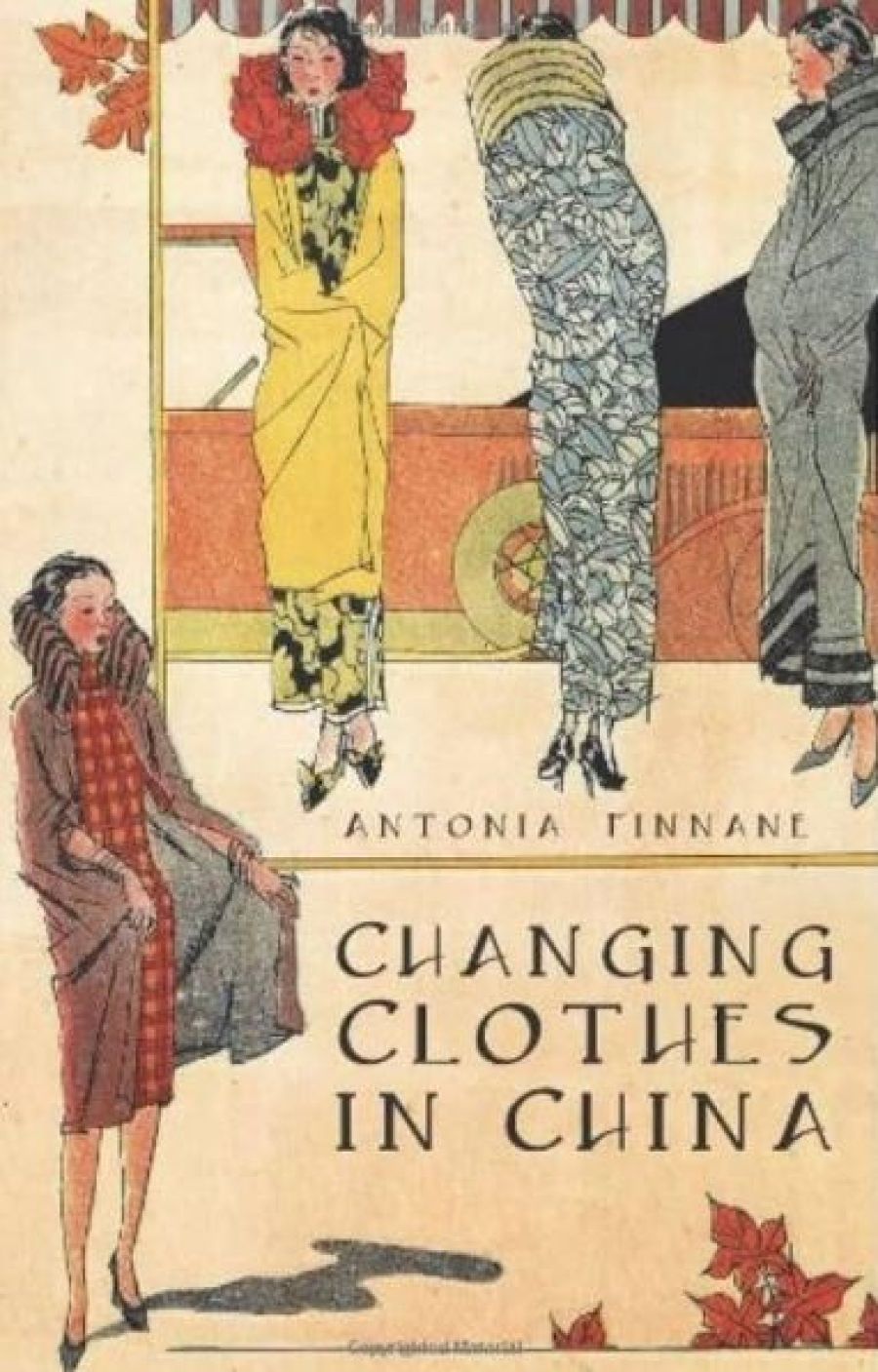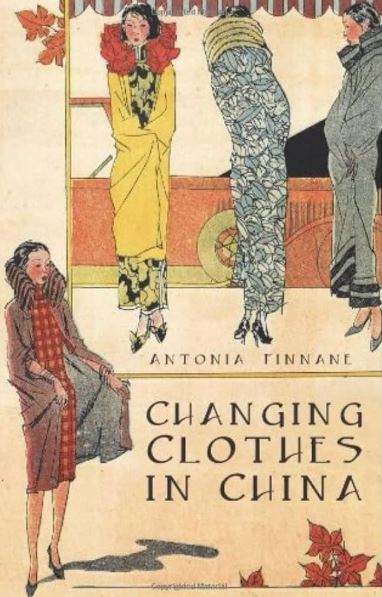
- Free Article: No
- Contents Category: Non-fiction
- Review Article: Yes
- Article Title: Serious Fashion
- Online Only: No
- Custom Highlight Text:
The juxtaposition of the three words ‘fashion,’ ‘history’ and ‘nation’ in the title of Antonia Finnane’s study of Chinese clothing indicates the ambitious nature of her richly illustrated book. Her account is an engaging one, based in detailed analysis of the social and political circumstances that shaped not only what people wore but the body shapes they cultivated as well. Finnane, an associate professor of history at the University of Melbourne, tells us that her narrative of vestimentary change across a century or more in China is aimed at showing how ‘the relationship between national politics and fashion is not simple, predictable or steady’, in tandem with an analysis of how technology, industry, commerce and modern communications each played a significant part in changing Chinese styles of dress.
- Book 1 Title: Changing Clothes in China
- Book 1 Subtitle: Fashion, History, Nation
- Book 1 Biblio: UNSW Press, $59.95 hb, 360 pp
- Book 1 Cover Small (400 x 600):
- Book 1 Cover (800 x 1200):
Finnane’s magisterial work is the first book-length Anglophone history of Chinese fashion. Throughout, she achieves a fine balance between vivid observations of human experience and nuanced analysis of the historical contexts in which styles of dress changed and developed. The affective force of fashion, like rock music and other forms of popular culture, can easily be dulled by ponderous academic prose and abstruse theoretical propositions. Finnane’s book poses no danger of stultifying Chinese fashion.
On the contrary, it brings to life a rich array of Chinese sensibilities to fashion about which most people (both outside and within China) are likely unaware. Finnane seeks at every opportunity to alert us to the Eurocentrism implicit in our use of the word ‘fashion’. Thus she opens her book with the self-evident statement that, ‘A century ago, people in China dressed in clothes very different to those worn today’, as a pointed reminder of our insensitivity to changing dress styles in China. More importantly, her book celebrates the joys that Chinese people have experienced in wearing what is ‘in’, even though the preferred styles in China (especially during the Maoist years of the 1960s and 1970s) might bear little or no resemblance to the fashion trends that held people in thrall outside China.
Each of the eleven chapters of Finnane’s book provides a nuanced account of the key issues under consideration. She has chosen to discuss Chinese fashion chronologically. The first and introductory chapter offers a persuasive argument for understanding the evolution of fashion across different eras of China’s twentieth century as guided by contending visions of Chinese modernity. The desire among prominent historical individuals to embody the nation’s character in their styles of dress is a powerful undertow that Finnane weaves into her narrative through the inclusion of a rich variety of comments by such individuals and through her own critical engagement with their comments. For instance, in discussing the phrase ‘bound feet and Western dress’, which Zhang Youyi, a stylish woman of the 1920s, once used to describe the awkward appearance of a traditional foot-bound Chinese woman in Western-style dress, Finnane also alerts us to the opportunistic use that Zhang’s unfaithful husband (the celebrated Republican-era poet Xu Zhimo) made of that same phrase to demand a divorce (on the grounds that Zhang was ‘culturally foot-bound, despite her natural feet’). Finnane then invites us to ponder why no one took exception to the equally jarring effect of ‘bound feet and Chinese dress’.
Finnane’s engagement with bound feet and the Eurocentric presumption that China lacks fashion is more fully elaborated in the second chapter. Among other things, she argues that the historical rise of European hegemony was reflected in European perceptions about foot-binding that shifted over time, from commonsensical sixteenth-century observations about foot-binding, as an aesthetics and as a means of keeping women in the house, to strident nineteenth-century denunciations of the practice as evidence of China’s moral decrepitude. From chapters three to eleven, she provides a rich and detailed account of changing styles of dress in China from the nineteenth century to the present day. She shows how Chinese attitudes to fashion were progressively shaped by the politics of seeing and feeling in a world under Western dominance. In particular, she traces the evolution of comparisons within Republican China of ‘civilised’ and ‘barbaric’ forms of dress through the frequent value-laden descriptions of different sartorial habits and attitudes that appeared in new-style Chinese fiction, social commentary and diary jottings.
Finnane devotes particular attention to the complex symbolism developed around such dress styles as the qipao (or cheongsam) for women; and the traditional long gown (changpao) and the Sun Yatsen suit for men that became emblematic of Chinese culture in different periods of the twentieth century. In taking us on a tour of the aesthetic and political motivations that led trendsetters in twentieth-century China to wear or to abandon these garments in a given time or place, she puts us within proximity of their desires to appear a certain way to their fellow citizens and to foreigners.
She alerts us to the importance of the happenstance in the genealogy of such garments, recounting, for instance, one among several different accounts of the Sun Yatsen suit that traces the suit’s origin to an ad hoc decision that Sun once made, when asked to inspect the troops in Guangzhou, to wear a relatively modest hunting suit as opposed to a Western outfit or a formal commander’s uniform. Moreover, she draws our attention to the claims made by prominent women such as Oei Hui-lan (wife of Wellington Koo, China’s urbane ambassador to France and Great Britain in the 1930s and 1940s) of having introduced important innovations to the qipao, including slitting the gown to the knee, adding decorative trims to the side slits, and buttoning and unbuttoning the gown in a line extending from the collar to the underarm.
An important theme of Finnane’s book is the growing militancy of urban Chinese youth in reaction to the political violence of the first half of the twentieth century. In this regard, she shows us how the diverse dress styles of the 1920s and 1930s became progressively displaced by the prevalence of military-style unisex dress for men and women in the war-torn years of the late 1930s and 1940s. By the time of the founding of the People’s Republic in 1949, attire became conceived of largely in the ideological terms of an appropriate wardrobe for socialist citizens. In discussing the Cultural Revolution years of the 1960s and early 1970s, Finnane draws our attention to how Chinese youth craved to be attired in military uniforms of blue, green and grey in their determination to be perceived as members of the revolutionary ‘in crowd’.
She cites as representative of that age an aggressively militant article purportedly written by Song Binbin and published in 1966. Finnane does not note that Song has since claimed that party propagandists wrote and published the article without her consent, that they had hijacked her identity to rally support for the Cultural Revolution simply because she was the first student to pin a Red Guard armband on Chairman Mao. Despite this omission, Finnane convincingly shows us that throughout the Maoist years, what people outside China would have dismissed as drab attire was very much in vogue within China. Her narrative then segues from the militarism fashionable under Mao to the post-Maoist rebirth of commercial fashion since the 1980s.
Throughout the book, Finnane traces the socio-political, technological and commercial developments that facilitated the rise to popularity of particular styles of dress. Her panoramic grasp recalls the masterful monologue on cerulean blue that Meryl Streep delivered in her role as Miranda Priestly in The Devil Wears Prada (2006), in which Priestly tells her new assistant to show respect for the ‘millions of dollars and countless jobs’ generated when cerulean blue was in vogue. But unlike the austerely capitalist Priestly, Finnane is sympathetic to the socialist aspirations that have shaped Chinese sartorial habits, and her unwavering insistence on a non-Eurocentric reading of fashion is exemplary. This is a thought-provoking book from which general and specialist readers alike will learn a great deal.



Comments powered by CComment